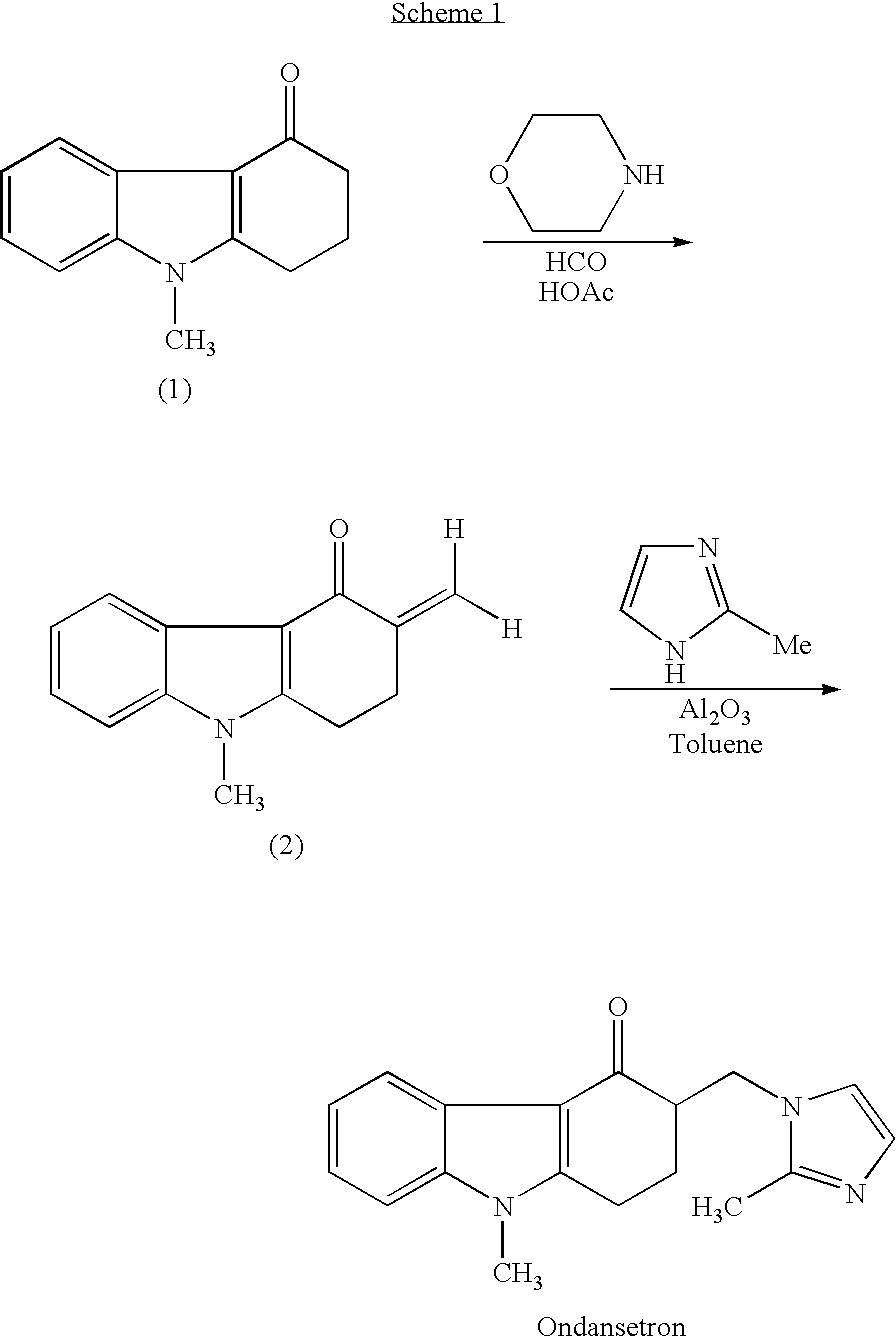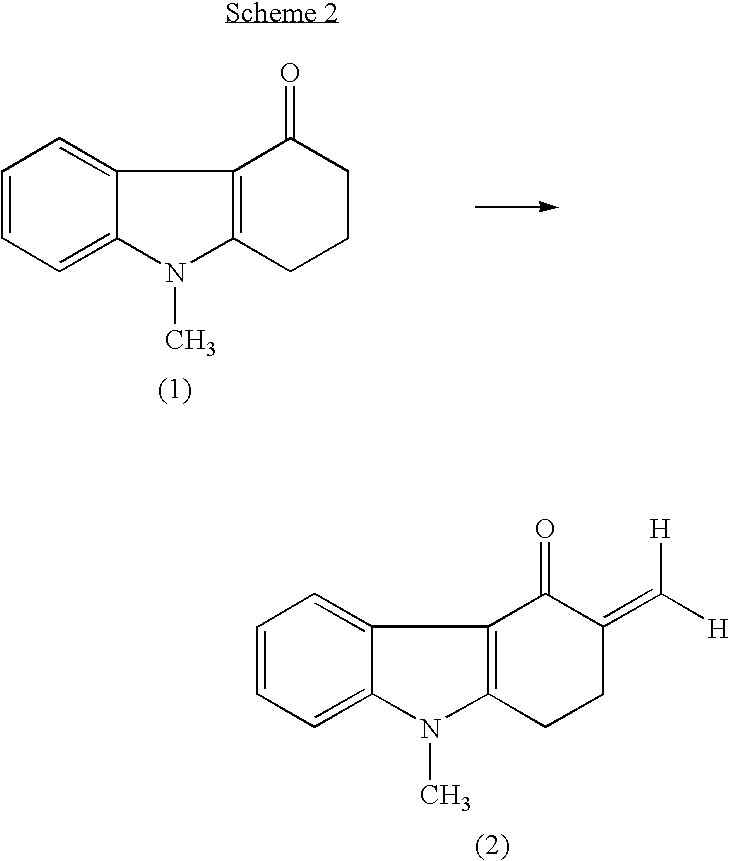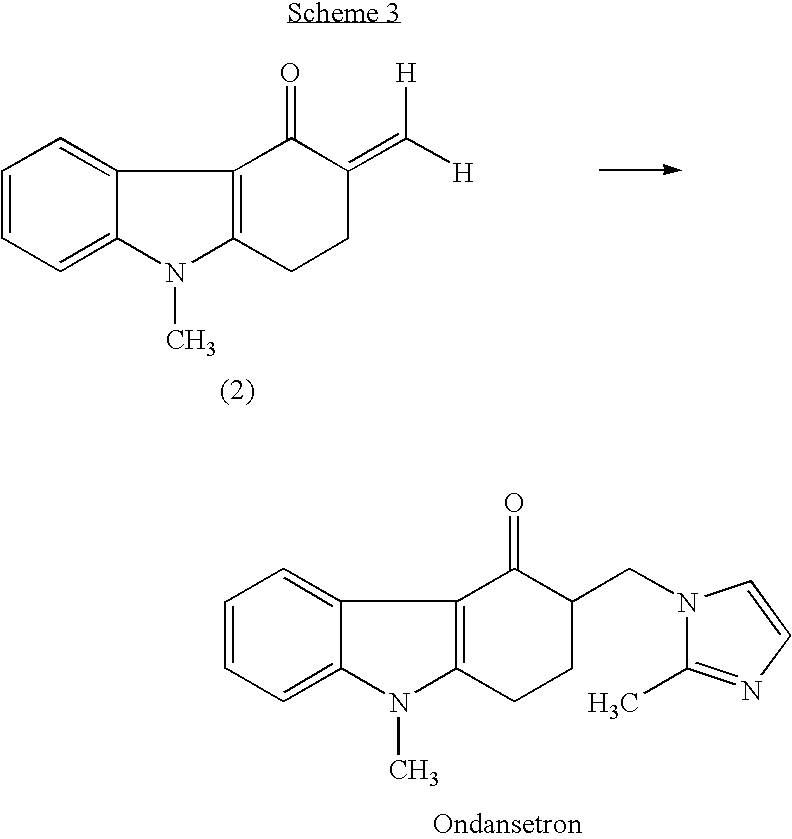Process for preparing 1,2,3,9-tetrahydro-9-methyl-3-methylene-4H-carbazol-4-one and ondansetron therefrom
a technology of ondansetron and process, which is applied in the field of process for preparing 1, 2, 3, 9tetrahydro9methyl3methylene4hcarbazol4one and a process for preparing ondansetron therefrom, can solve the problems of glacial acetic acid combustible, toxic, toxic, and easy to absorb, and achieves short reaction time, efficient and convenient, and high yield
- Summary
- Abstract
- Description
- Claims
- Application Information
AI Technical Summary
Benefits of technology
Problems solved by technology
Method used
Image
Examples
example 1
Synthesis of 1,2,3,9-Tetrahydro-9-methyl-3-methylene-4H-carbazol-4-one (Without Using Glacial Acetic Acid or Secondary Amine)
[0111] 1,2,3,9-tetrahydro-9-methyl-4H-carbazol-4-one (1.75 grams; 8.8 mmol), paraformaldehyde (1.55 grams; equivalent to about 50 mmol CH2O), and 0.25 mL (2 mmol) concentrated HCl (32% (w / w)) were added to N,N-dimethylformamide (8.75 mL). The mixture was heated to 110° C.
[0112] At various time points during the reaction, samples were collected and analyzed by thin-layer chromatography (TLC). The ratio of product (1,2,3,9-tetrahydro-9-methyl-3-methylene-4H-carbazol-4-one) to starting material (1,2,3,9-tetrahydro-9-methyl-4H-carbazol-4-one) in the samples was visually estimated. The results are shown in the following table 1.
TABLE 1Ratio of 1,2,3,9-tetrahydro-9-methyl-3-methylene-4H-carbazol-4-one to 1,2,3,9-Timetetrahydro-9-methyl-4H-carbazol-4-one1 hour50 / 502 hours60 / 403 hours70 / 304 hours80 / 205 hours85 / 15Overnight100 / 0*
*only traces of 1,2,3,9-tetrahydro-9...
example 2
Synthesis of 1,2,3,9-Tetrahydro-9-methyl-3-methylene-4H-carbazol-4-one-(Optional Use of Ammonium Chloride)
[0114] In this reaction, we studied the optional use of ammonium chloride. The reaction was performed under conditions identical to those used in Example 1, except that ammonium chloride (0.045 grams; 0.85 mmol) was included in the reaction.
[0115] At various time points during the reaction, samples were collected and analyzed by thin-layer chromatography (TLC). The ratio of product (1,2,3,9-tetrahydro-9-methyl-3-methylene-4H-carbazol-4-one) to starting material (1,2,3,9-tetrahydro-9-methyl-4H-carbazol-4-one) in the samples was visually estimated. The results are shown in the following table 2.
TABLE 2Ratio of 1,2,3,9-tetrahydro-9-methyl-3-methylene-4H-carbazol-4-one to 1,2,3,9-Timetetrahydro-9-methyl-4H-carbazol-4-one1 hour60 / 402 hours70 / 303 hours80 / 204 hours90 / 105 hours95 / 5 Overnight100 / 0*
*appeared to be no 1,2,3,9-tetrahydro-9-methyl-4H-carbazol-4-one remaining
[0116] Acco...
example 3
Large Scale Synthesis and Isolation of 1,2,3,9-tetrahydro-9-methyl-3-methylene-4H-carbazol-4-one
[0117] We studied large-scale synthesis by increasing the quantity of reagents by 100-fold as compared to Example 2, and isolating the product of the reaction (i.e., 1,2,3,9-tetrahydro-9-methyl-3-methylene-4H-carbazol-4-one). 1,2,3,9-tetrahydro-9-methyl-4H-carbazol-4-one (175 grams; 0.88 mol), paraformaldehyde (155 grams; equivalent to about 5 moles of CH2O), ammonium chloride (45 grams; 0.84 mol), and concentrated (32% (w / w)) hydrochloric acid (25 mL; 0.2 mol) were added to N,N-dimethylformamide (875 mL).
[0118] The mixture was heated for 5-6 hours at 120° C. At this point, thin-layer chromatography (TLC) indicated complete conversion of 1,2,3,9-tetrahydro-9-methyl-4H-carbazol-4-one to 1,2,3,9-tetrahydro-9-methyl-3-methylene-4H-carbazol-4-one. The solution was cooled to room temperature (about 20-25° C.), and ice water (2 L) was added.
[0119] The resulting white precipitate was collecte...
PUM
| Property | Measurement | Unit |
|---|---|---|
| temperature | aaaaa | aaaaa |
| boiling point | aaaaa | aaaaa |
| temperature | aaaaa | aaaaa |
Abstract
Description
Claims
Application Information
 Login to View More
Login to View More - R&D
- Intellectual Property
- Life Sciences
- Materials
- Tech Scout
- Unparalleled Data Quality
- Higher Quality Content
- 60% Fewer Hallucinations
Browse by: Latest US Patents, China's latest patents, Technical Efficacy Thesaurus, Application Domain, Technology Topic, Popular Technical Reports.
© 2025 PatSnap. All rights reserved.Legal|Privacy policy|Modern Slavery Act Transparency Statement|Sitemap|About US| Contact US: help@patsnap.com



